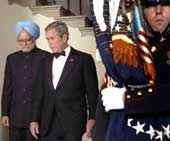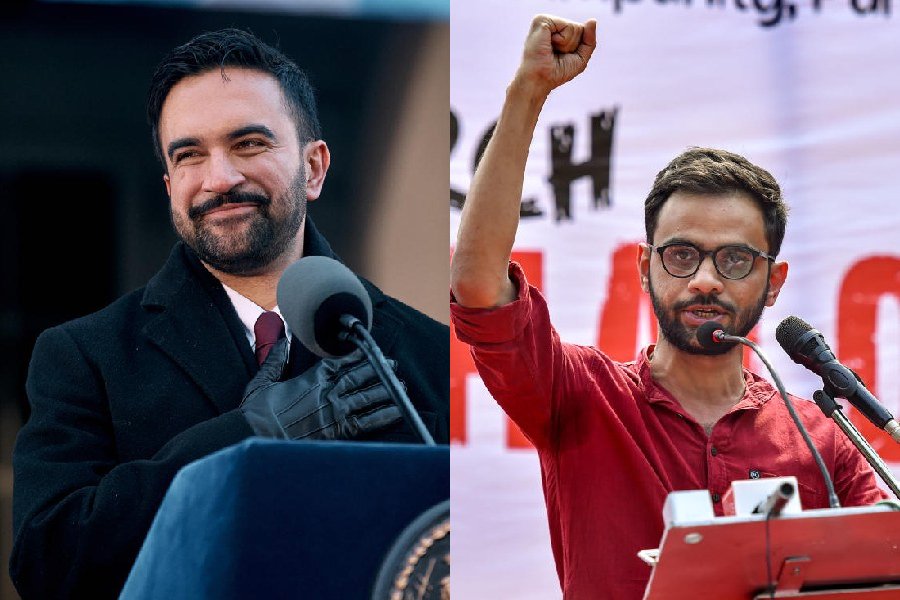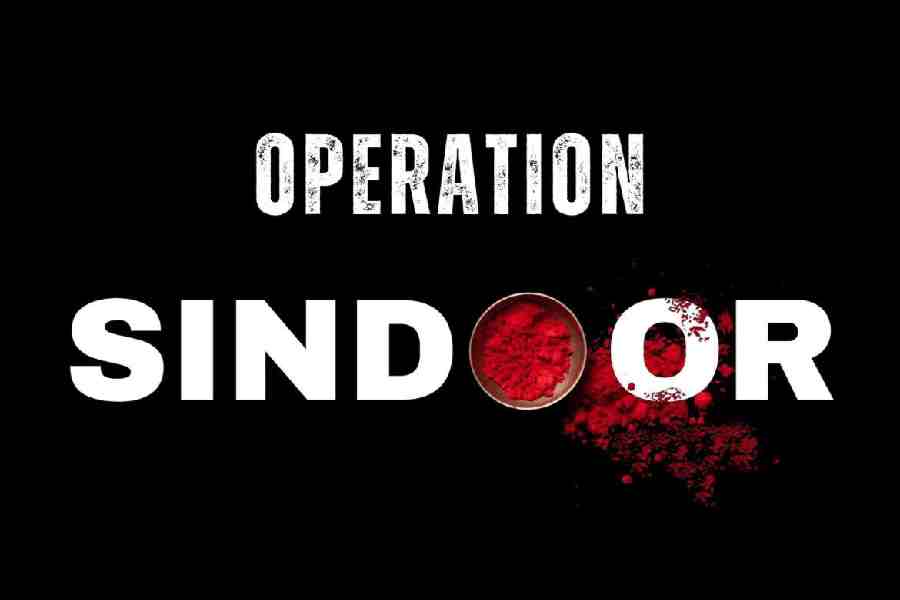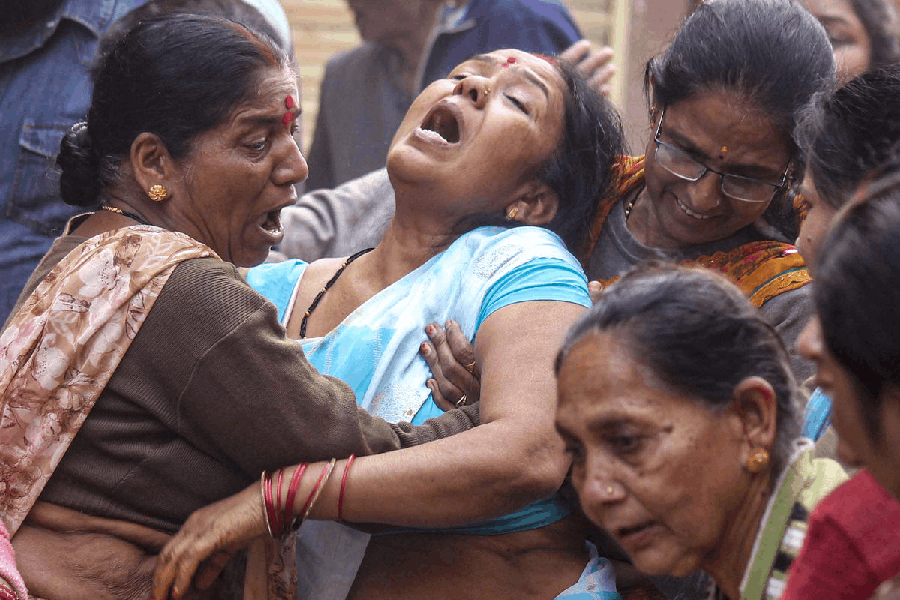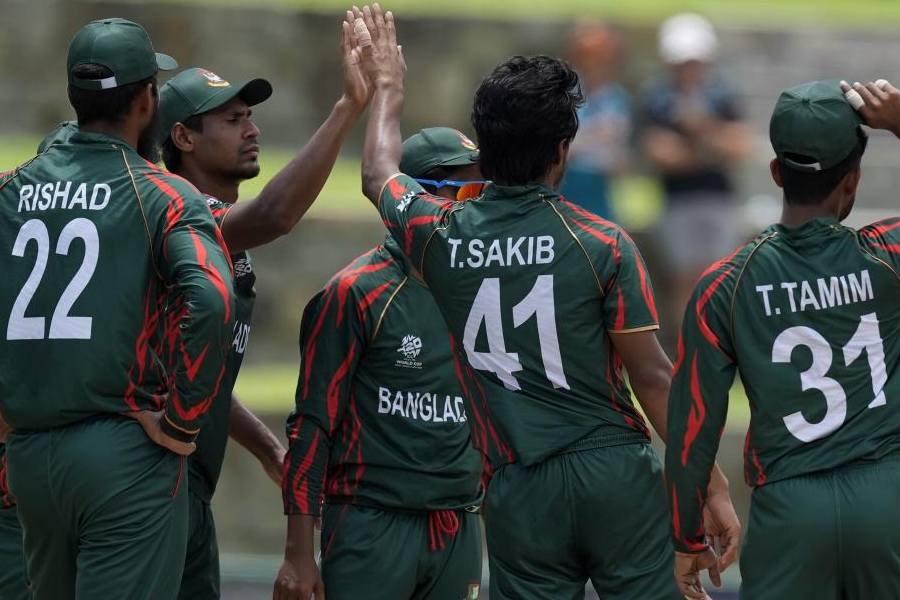|
|
| Doing his bit |
Take a bow, Maureen Dowd. George W. Bush should go down in history at least for the one good turn he has done India. The eminently readable columnist of The New York Times has livened up many a grim morning around the world with her ability to sink her teeth into George Bush’s dyslexic foreign policy. Iraq, Afghanistan, Palestine, Pakistan — in the endless roll call of things falling apart, she has argued, the centre has just refused to hold in Washington.
And then there is India, the jewel in the Bush administration’s crown. The nuclear deal concluded with it last week is already dismembering the world as we have known it since Yalta-Potsdam in 1945.
It was no coincidence that Messrs Stalin, Churchill/Attlee and Roosevelt/Truman, victors of World War II, carved up the world between themselves and the French (although China came later in 1964, courtesy Nehru). That is, the Permanent Five had the exclusive use of the veto in the United Nations security council and were the only ones privileged to exercise their nuclear ambitions.
And now there are six. In all but name, India is the world’s sixth nuclear weapons power. The delicious irony is that when Delhi went nuclear in 1998, it was the Americans, huffing and puffing, who had sanctimoniously laid down the sanctions. “India has dug itself into a hole,” the then secretary of state, Madeleine Albright, had warned.
Still, as India savours all the attention (two stories on nytimes.com on two consecutive days), it is the gripping inside story of the nuclear deal that should entice Ramachandra Guha to add an appendix to his history of India.
Truth is, at any point of time since July 18, 2005, when Manmohan Singh smiled beatifically as he stood next to Bush in the White House, there were always two sets of negotiations — the first between Indian and American negotiators, and the other, between the Indians themselves. In the end, whatever the pathbreaking deal is about, it is also about the people involved who made the deal happen.
It all began in July 2005, when the US secretary of state, Condoleezza Rice, allowed herself to be charmed by the then foreign minister, K. Natwar Singh (he with the rose in the achkan buttonhole), on her 50th birthday. Not that they delivered the deal, but it was a small beginning.
As for the prime minister, he knew, even then, that unless the atomic energy chief, Anil Kakodkar, was on his plane, nothing would ever come out of any negotiations. Then and now, in Washington and in Delhi, Kakodkar would clear negotiating tactic and strategy, although he did not have much photo-op.
So even as the Indo-US press sat inside the White House in July 2005, waiting for both leaders to emerge from the joint press conference, India’s national security adviser, M.K. Narayanan, could be seen poring over the draft. Narayanan knew that someone had to play the role of the devil’s advocate, and that the role would naturally fall upon him. For the last two years, he has gone over every clause with a toothcomb.
And yet it was Narayanan, who, around the time the prime minister’s special envoy, Shyam Saran, was eased out of the nuclear negotiations in March, really took over the deal. A former head of the Intelligence Bureau, who enjoyed the confidence of both Sonia Gandhi and the prime minister, Narayanan realized that he would have to tame the scientists. They were part of the sacred Indian inheritance, and public opinion would not have tolerated the “dirty politician” to denigrate their achievements.
So Kakodkar and Ravi Grover, his able colleague, were given a long rope to articulate their concerns. The dissent, however, could not be free-floating. It had to come with creative solutions. Secret negotiations in South Africa and London, over March and April, appeared to go some distance, but there was still no agreement over reprocessing fuel or on India’s right to test a nuclear weapon. Narayanan decided to turn the pressure on the scientists.
To their credit, Kakodkar-Grover came up with a sizzler of an answer: India would propose an additional facility, open to international inspection, in which the spent fuel from the civilian reactors would be stored before it was reprocessed. The simplicity of the solution took one’s breath away. However, the point is, the option had always existed with the scientists. Narayanan seemed to have decided that Kakodkar & Co could not be allowed to deny the United Progressive Alliance a place in history.
So when he spoke to his counterpart, Steve Hadley, about a week before they — and the prime minister and Bush — met in Heilingendamm, on the margins of the G-8 in Germany, Narayanan made the safeguarded facility proposal. At Heilingendamm, Manmohan Singh told Bush, who had nearly been felled by a stomach viral, “We will not be able to do this deal without reprocessing rights.’’
In Delhi, even a couple of days before the prime minister travelled to Germany, Nicholas Burns, the top US diplomat, had kept dragging his feet over reprocessing rights. That is, until his meeting with Narayanan, who told him bluntly that Burns’s boss, namely Bush, had promised India the same during his visit to India in March last year. George W. Bush was at the heart of the deal, and had always been so since those days in July 2005. He would have to be spoken to, again and again.
The job to do that fell upon India’s ambassador to the US, Ronen Sen. Sen is known to be a man of few words and is a workaholic. The details of Sen’s relationship with Bush are hardly known, but the truth is that he softened him up. He started by getting to know everything there was to know about the man the world so loved to hate. Such as the fact that he wakes up at the crack of dawn, and is an exercise fiend. “Bush loves India,” was all Sen would ever cryptically say.
In March 2006, when India and the US failed to break their nightlong deadlock before the talks the next morning, it was Bush who told Rice: “I want a deal with India.” Last month in Germany and last week in Washington, Bush had much the same message for Hadley. By now, India’s Fab Four — Narayanan, Sen, Kakodkar and the foreign secretary, Shivshanker Menon — had probably forgotten they still had a pulse or a heartbeat left.
So when Hadley called Narayanan in his hotel in Washington last week and said, “En route to your meeting with the Vice-President (Dick Cheney), could you drop by please?” Narayanan arrived at 1.30 pm. The day before, the two men had agreed to use the Kakodkar formula to resolve the reprocessing issue. That day, Hadley offered a solution on fuel supply assurances: if India ever conducted a test and US laws on all cessation of cooperation kicked in, the US would ensure that other countries like France and Russia helped India out with alternative supplies.
It was all over by lunch last Friday afternoon. Two years and two days, that is how long it had taken Bush to get India out of the hole Albright had put Delhi into.

